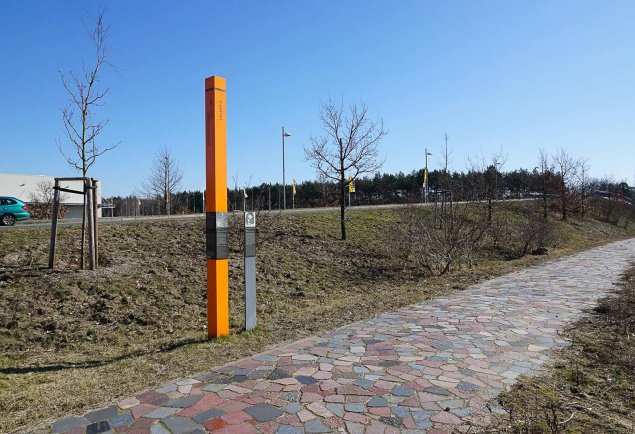born in 1971
suffocated to death while fleeing with his parents on January 22, 1973
at the Drewitz border crossing/ Dreilinden command post ("Checkpoint Bravo")
on the outer ring between Potsdam-Babelsberg and Berlin-Zehlendorf
The nerves of the fleeing couple were extremely on edge when the child began to cry. The mother tried in vain to quiet him and in panic held his mouth shut. Little Holger was suffering from an inflammation of the middle ear and bronchitis. The infection had probably also blocked his nasal passageway.
Little is known about why Ingrid and Klaus H. wanted to flee. [1] They had met in Moscow on a youth travel program. After their son was born they began their adult life together and were certain that they did not want to spend their life in East Germany: As a consequence of Klaus H.’s first escape attempt, which he undertook across the Baltic Sea with friends when he was 17, he had very limited career opportunities in East Germany. He was permanently marked as a „republic fugitive." Ingrid H. was probably tormented as a young teacher by the political patronizing she encountered, which was so typical of East Germany. They wanted to escape for themselves but also for their son: They did not want him to grow up under the constrictions that they had experienced as children and under which they suffered as young adults.
On a January night a truck belonging to a West Berlin acquaintance stopped on the parking lot of the transit highway. The couple climbed onto the back of the truck with their 15-month-old son and hid in large empty crates: The 23-year-old father was in one crate and the 20-year-old mother and child were in another. The truck stopped at the Drewitz border crossing. „The inspection at the Drewitz checkpoint took longer than usual," the driver of the truck later told the Berlin police. [2]
The nerves of the fleeing couple were extremely on edge when the child began to cry. The mother tried in vain to quiet him and in panic held his mouth shut. Little Holger was suffering from an inflammation of the middle ear and bronchitis. The infection had probably also blocked his nasal passageway. His mother did not realize that he was unable to breathe through his nose. The escape was a success; the family made it through without being discovered. The truck drove another 300 meters and then the crates were opened. „My child," Ingrid H. cried out immediately and held her motionless child out to the helpers on the western command post. Holger H. was not breathing anymore and all attempts to revive him failed.
The 15-month-old Holger H. was to be buried in a cemetery in Berlin-Marienfelde. [3]
Martin Ahrends/Udo Baron
On a January night a truck belonging to a West Berlin acquaintance stopped on the parking lot of the transit highway. The couple climbed onto the back of the truck with their 15-month-old son and hid in large empty crates: The 23-year-old father was in one crate and the 20-year-old mother and child were in another. The truck stopped at the Drewitz border crossing. „The inspection at the Drewitz checkpoint took longer than usual," the driver of the truck later told the Berlin police. [2]
The nerves of the fleeing couple were extremely on edge when the child began to cry. The mother tried in vain to quiet him and in panic held his mouth shut. Little Holger was suffering from an inflammation of the middle ear and bronchitis. The infection had probably also blocked his nasal passageway. His mother did not realize that he was unable to breathe through his nose. The escape was a success; the family made it through without being discovered. The truck drove another 300 meters and then the crates were opened. „My child," Ingrid H. cried out immediately and held her motionless child out to the helpers on the western command post. Holger H. was not breathing anymore and all attempts to revive him failed.
The 15-month-old Holger H. was to be buried in a cemetery in Berlin-Marienfelde. [3]
Martin Ahrends/Udo Baron
[1]
On the following see „Tragisches Ende einer Flucht mit dem Lastwagen – Kind erstickte während der Kontrolle in den Armen seiner Mutter," in: Berliner Morgenpost, 24.1.1973; „15monatiges Kind erstickte bei Flucht der Eltern nach Berlin," in: Der Tagesspiegel, 24.1.1973; „Kind starb auf der Flucht in den Westen," in: Die Welt, 24.1.1973; „Bei der Flucht nach West-Berlin: Baby erstickte im Arm der Mutter," BZ, 24.1.1973; „Ich nehme die Flüchtlinge bei mir auf," in: BZ, 25.1.1973; „Wir würden das nie wieder tun," in: BZ, 30.1.1973.
[2]
Berliner Morgenpost, 24.1.1973.
[3]
This was reported by the B.Z. in its issue of 25/1/1973. According to the cemetery administration, the grave site in the Marienfelde cemetery does not exist (anymore).


